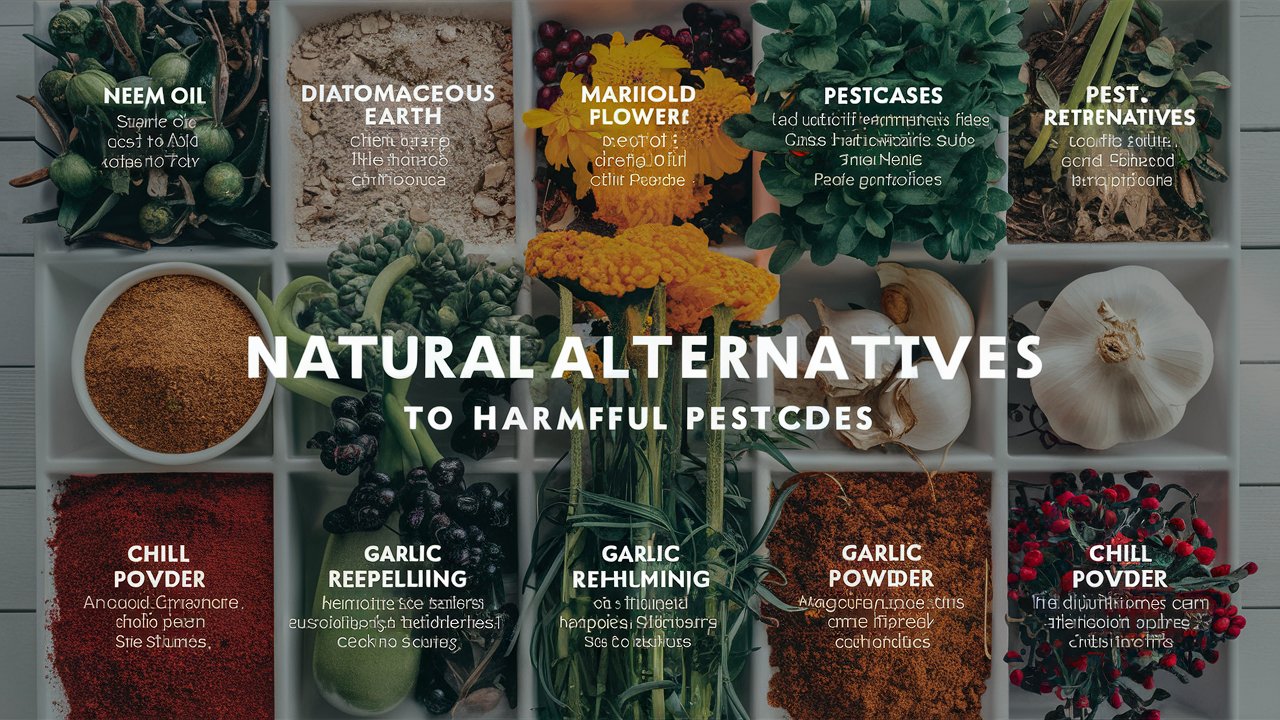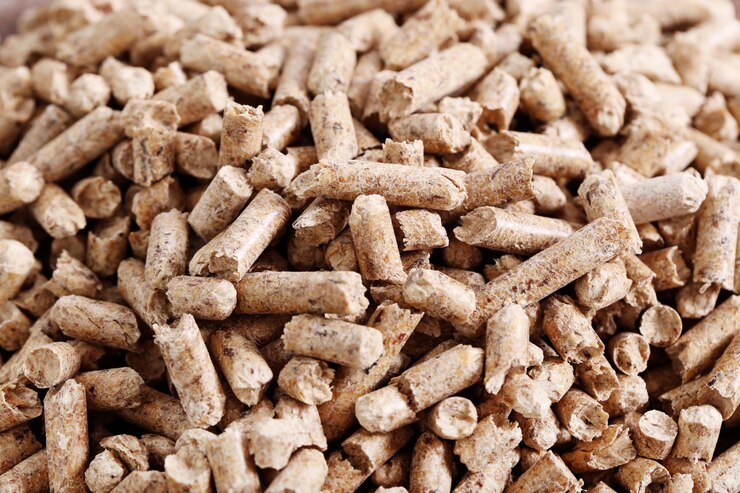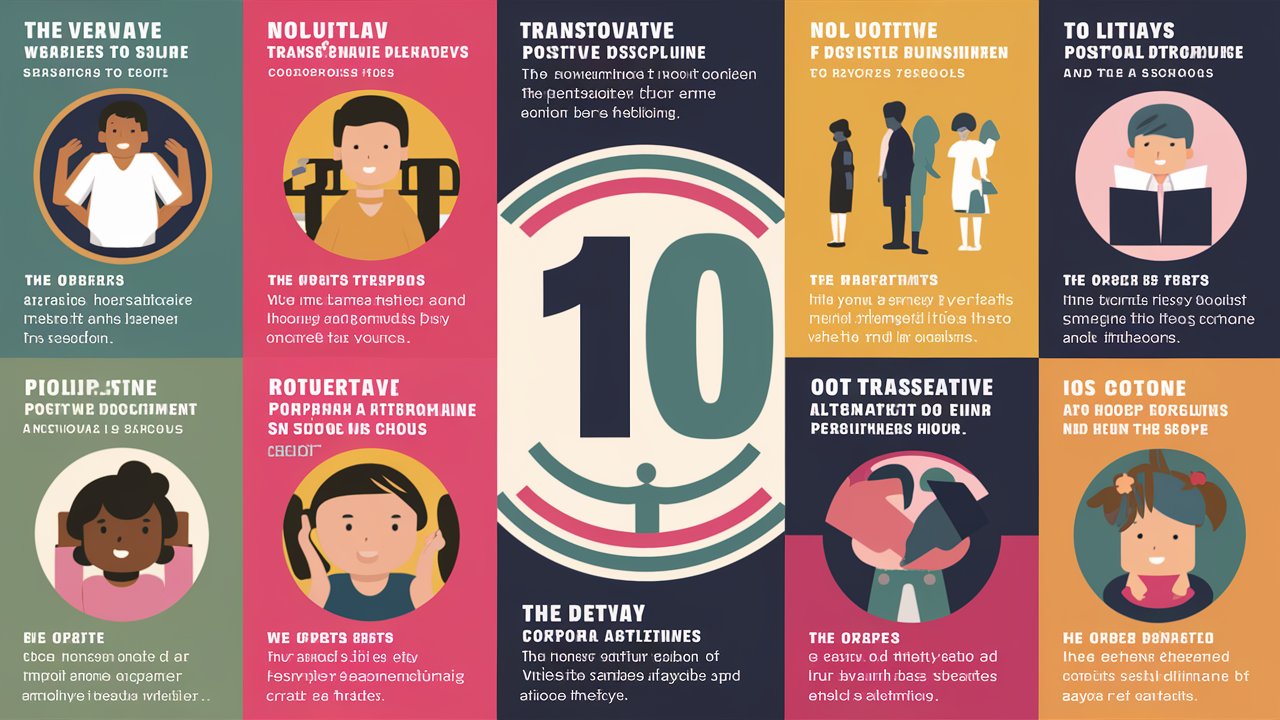Here is a table of the top 10 natural alternatives to harmful pesticides, along with their pros and cons:
| Alternative | Pros | Cons |
|---|---|---|
| Bacillus thuringiensis (Bt) | – Effective against certain caterpillars and beetle larvae – Nontoxic to humans, pets, and most beneficial insects |
– Limited effectiveness against some pests
– Requires repeated applications
| Diatomaceous earth | – Controls crawling insects like ants, cockroaches, and slugs – Natural, nontoxic mineral |
– Needs to be reapplied after rain or watering
– Can be irritating to lungs if inhaled | |
| Neem oil | – Disrupts insect life cycles at all stages – Biodegradable, nontoxic to pets, birds, and wildlife |
– Needs to be reapplied regularly
– Can cause leaf burn if applied in direct sunlight
| Horticultural oils | – Effective against many common insect pests – Dormant oils can be used in winter |
– Needs thorough coverage to be effective
– Can damage plants if used improperly
| Peppermint, thyme, rosemary oils | – Repels a variety of insects without killing them |
– Effectiveness may vary
– Needs frequent reapplication
| Insecticidal soaps | – Effective against aphids, mites, thrips, and other soft-bodied insects |
– Only kills insects directly contacted by the spray
| Vinegar | – Effective natural herbicide for weeds – Inexpensive and readily available |
– Non-selective, can damage desirable plants
– Works best on small, young weeds
| Corn gluten meal | – Prevents weed seed germination |
– Ineffective on established weeds
– Can be harmful to people with corn allergies
| Iron-based herbicides | – Effective on many broadleaf weeds – Nontoxic to humans and pets |
– Less effective on grassy weeds
– Can stain concrete and other surfaces
| Boric acid | – Controls ants, cockroaches, silverfish, and termites |
– Toxic if ingested in large amounts
– Needs to be applied carefully to avoid exposure.
In a world where vibrant green gardens and flourishing crops often fall victim to the invisible perils of synthetic pesticides, the pursuit of a safer sanctuary for both plant life and our planet has never been more urgent.
Beyond their immediate pest-controlling prowess, pesticides unleash a sinister ripple effect, poisoning ecosystems and endangering the delicate balance that sustains life. Now, as we stand at the crossroads of verdant promise and lurking peril, there emerges a compelling beacon of hope – natural alternatives – guardians of both health and harmony.
As gardeners, environmental stewards, or simply enthusiasts of sustainable living, ushering in a new era requires a deliberate shift in perspective – one that looks beyond quick fixes laden with chemicals towards holistic solutions rooted in nature’s bountiful wisdom.
Enter the realm of natural alternatives to harmful pesticides; an arsenal teeming with botanical brilliance and ecologically-friendly strategies. Harnessing the power of marigolds standing tall sentinels or inviting ladybugs as watchful allies may spark visions of thriving gardens untouched by toxic residues.
Embracing these natural warriors against pests beckons us to redefine pest control not merely as warfare but as harmonious coexistence with nature’s intricate web.
Non-Chemical Barriers.
In the quest for a pesticide-free garden, non-chemical barriers are your allies in the war against pests. These natural alternatives not only safeguard your plants but also contribute to a healthier ecosystem.
One effective method is harnessing the power of nature by planting marigolds, lavender, or other pest-repellent plants strategically around your crops. The aromatic defenses of these flowers create an invisible shield, deterring unwanted invaders without the need for harmful chemicals.
Additionally, employing physical barriers like row covers, netting, or screens can provide a sturdy defense against insects seeking to snack on your hard-earned harvest. Not only do these barriers act as impenetrable walls for pests, but they also offer protection from unpredictable weather conditions.
Another ingenious strategy involves recruiting nature’s own warriors – beneficial insects such as ladybugs and praying mantises. These tiny but mighty allies act as biological pest control agents, preying on unwelcome guests in your garden naturally without disrupting the delicate balance of the ecosystem.
By embracing non-chemical barriers in your gardening practices, you embrace a sustainable approach that respects both your plants and the environment at large. It’s empowering to know that with thoughtful planning and strategic placement of pest-repellent plants or physical shields, you can cultivate a thriving garden free from harmful pesticides.
Embrace these natural alternatives not only as tools for pest management but also as guardians of biodiversity within your green oasis.
Companion Planting for Natural Pest Control.
Companion planting is like nature’s version of teamwork in your garden. By strategically pairing certain plant species together, you can create a natural defense system against pests and foster a symbiotic environment.
For example, planting basil near your tomato plants not only adds flavor to your culinary creations but also helps deter tomato hornworms due to the strong aroma basil emits. This aromatic interference confuses pests and disrupts their ability to locate their preferred hosts, protecting your tomatoes naturally.
Another classic example of companion planting is the partnership between dill and cucumbers. Dill acts as a powerful natural pest deterrent for cucumber beetles and other harmful insects that feed on cucumber plants.
The fragrant dill herbs mask the scent of the cucumbers, making it difficult for pests to find them. Additionally, some plants release compounds into the soil that repel specific pests or attract beneficial insects like pollinators or predatory bugs, creating a harmonious ecosystem within your garden.
The beauty of companion planting lies in its ability to enhance growth while minimizing the need for chemical interventions. By integrating diverse plant species that support each other’s growth and defense mechanisms, you’re building a resilient ecosystem where pests are naturally managed without compromising plant health.
These intelligent plant combinations not only benefit your garden but also educate us on the intricate relationships present in nature that we can harness for sustainable pest control practices.
Organic Sprays and Mixtures.
When it comes to combating garden pests, turning to organic sprays and mixtures can be a game-changer. Imagine concoctions brewed from ingredients like neem oil, garlic, hot pepper, or soap being your allies in the fight against unwanted critters.
These homemade remedies not only effectively control common pests but also safeguard the health of your plants and surrounding environment.
In the realm of pest control, emphasizing the shift towards using organic alternatives like homemade insecticidal soaps over synthetic chemical sprays is paramount. By opting for natural solutions, you not only safeguard your garden but also contribute positively to ecological balance.
Imagine turning your kitchen into a laboratory where recipes for natural concoctions are crafted, targeting specific pests without leaving harmful residues that may harm other beneficial insects or wildlife.
Picture yourself mixing up a batch of garlic spray to ward off aphids or whipping up a neem oil solution to tackle pesky caterpillars without harming ladybugs. These DIY organic sprays are not just about killing pests; they are about nurturing a harmonious ecosystem within your garden.
So next time you spot unwanted visitors munching on your prized plants, reach for these natural potions that promise effective pest control while ensuring the well-being of all living beings in your green oasis.
Biological Controls for Pest Management.
When it comes to natural pest management in your garden, biological controls offer a sustainable and effective solution. Instead of resorting to chemical pesticides that can harm beneficial insects and contaminate the environment, introducing living organisms like nematodes or fungi can target specific pests without causing collateral damage.
For example, beneficial nematodes are microscopic worms that feed on soil-dwelling pests like grubs or caterpillars, naturally reducing their populations. By harnessing these tiny allies, you can protect your plants while maintaining ecological balance in your garden.
One of the key benefits of using biological controls is the precision they offer in targeting pest species. Unlike broad-spectrum chemical pesticides that affect various insects indiscriminately, introducing natural enemies like predatory insects, bacteria, or viruses allows for a more targeted approach to pest management.
For instance, releasing predatory ladybugs or lacewings into your garden can help control aphid populations without harming bees or butterflies. By leveraging the power of nature’s own checks and balances, you create a harmonious ecosystem where pests are kept in check naturally.
In sustainable agriculture practices globally, biological controls have emerged as a cornerstone of integrated pest management strategies. Farms and gardens worldwide have successfully implemented strategies such as augmentative releases of beneficial insects or microbial agents to minimize reliance on synthetic chemicals.
For example, greenhouses often utilize biological controls like parasitic wasps to combat whitefly infestations without compromising crop health or environmental safety. By embracing these innovative approaches to pest control, growers can cultivate healthy produce while preserving biodiversity in their agricultural landscapes.
By incorporating biological controls into your gardening practices, you not only protect your plants from destructive pests but also contribute to the overall health of your ecosystem. Whether it’s deploying fungi that parasitize plant pathogens or introducing beneficial bacteria that outcompete harmful microbes, these natural solutions bolster plant resilience and reduce the need for toxic chemicals.
As you explore the fascinating world of biological controls in pest management, remember that working with nature is not only effective but also empowering as you become a steward of biodiversity in your own backyard.
Crop Rotation and Soil Health.
Crop rotation is a time-honored agricultural practice that disrupts the life cycles of pests by altering the types of crops grown in specific locations each season. By changing which plants are placed where, gardeners can help break the reproductive patterns of insects that rely on a constant food source to thrive.
For example, planting legumes like peas or beans followed by brassicas such as broccoli or cabbage can naturally inhibit soil-dwelling pests like root-knot nematodes, reducing their numbers over time without resorting to harmful chemicals.
Maintaining healthy soil through practices like composting and mulching can work wonders for boosting plant immunity against pests. Nutrient-rich compost not only enriches the soil but also promotes beneficial microbial activity that supports plant health.
Mulching not only conserves moisture and suppresses weeds but also acts as a natural barrier against certain pests. For instance, a layer of straw mulch can deter cucumber beetles from feasting on young cucumber plants by making it harder for them to reach the tender stems.
Diverse plantings play a crucial role in supporting natural predators that keep pest populations in check while decreasing vulnerability to large-scale infestations. In a biodiverse garden, predatory insects like ladybugs or lacewings find refuge among various plants, preying on harmful bugs that might otherwise multiply rapidly without intervention.
Additionally, companion planting strategies that involve mixing different species together can confuse pests and prevent them from homing in on their preferred hosts. This interplanting approach not only confuses common garden foes but also provides a visually appealing landscape with multiple benefits for both plants and wildlife.
By implementing crop rotation, maintaining soil health through organic practices, and embracing biodiversity in your garden, you can create an ecosystem where nature’s checks and balances work harmoniously to manage pest pressures without relying on harmful pesticides.
These sustainable methods empower gardeners to cultivate resilient landscapes that thrive with minimal intervention while promoting a healthier environment for all living creatures within the garden ecosystem.
Choose Natural, Garden Safely.
As you explore the realm of natural pest control in your garden, remember that simplicity often outshines complexity. DIY traps using common household items like beer for slugs and vinegar for fruit flies can be surprisingly effective at keeping unwanted guests at bay.
Embrace techniques like sticky tape barriers to deter crawling insects naturally without resorting to harmful chemicals that disrupt the ecosystem you work so hard to nurture.
By opting for natural alternatives over harmful pesticides, you’re not only safeguarding your health and the environment but also fostering a thriving and balanced garden ecosystem. The benefits extend beyond mere pest control; they encompass promoting biodiversity, preserving beneficial insects, and ensuring a sustainable future for your green oasis.
So go ahead, experiment with different methods tailored to your unique gardening needs, and revel in the harmony of a pesticide-free paradise where nature’s solutions reign supreme.
I am commitment to crafting compelling narratives and delivering insightful content continues to inspire and inform readers across various platforms. Explore her articles on AlternativesZone.com and FactAfterFact.com to experience a rich tapestry of knowledge and discovery. Here I Analyze and Test the products and services together with my team before we recommend them to our users. Nice Reading Here!











